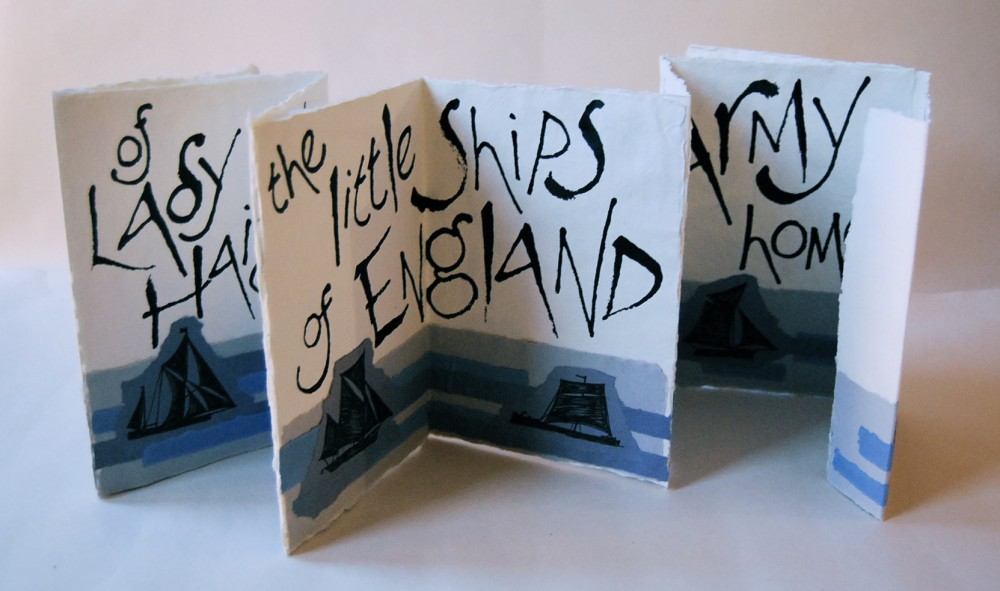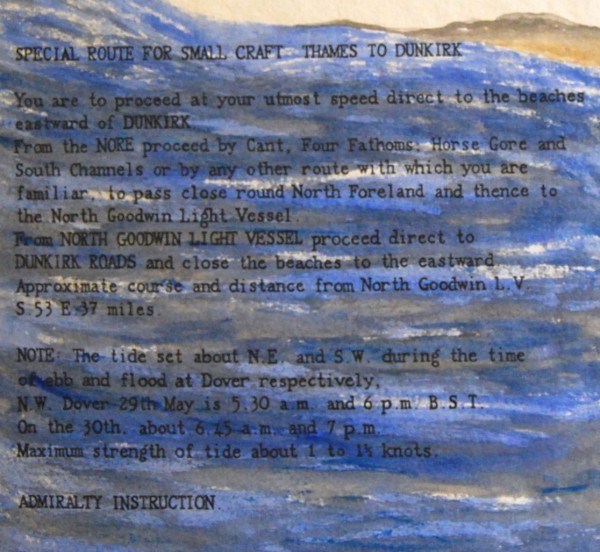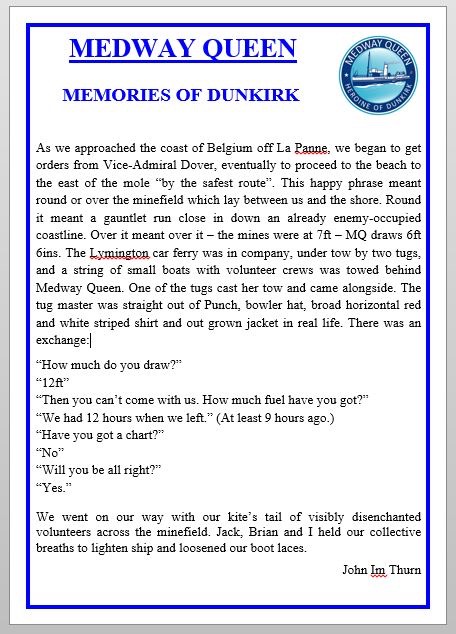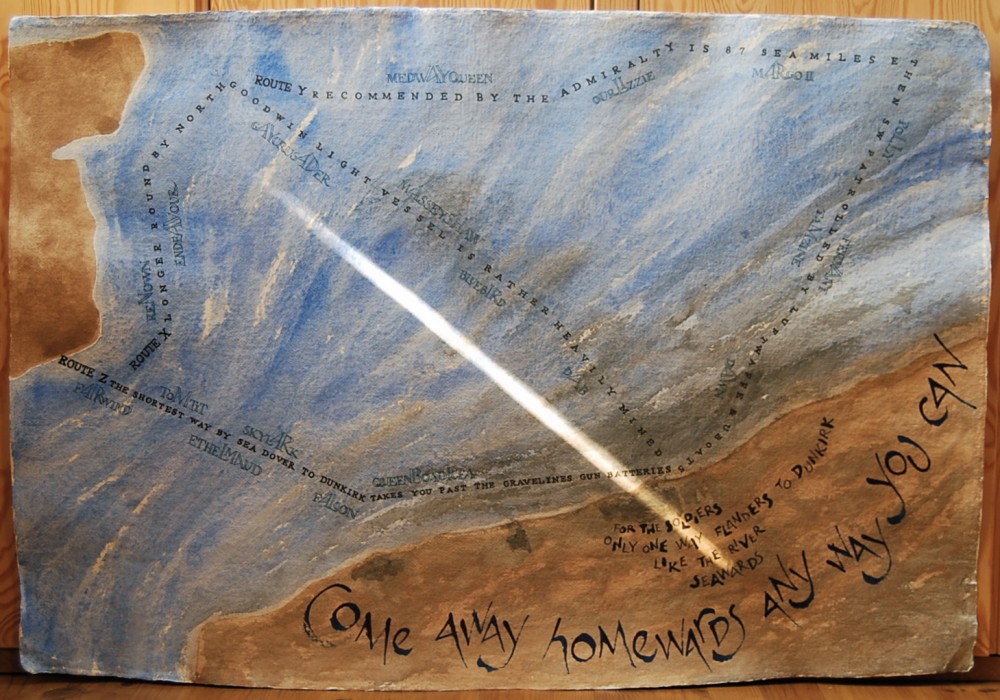
The Admiralty have made an Order requesting all owners of self-propelled pleasure craft between 30′ and 100′ in length to send all particulars to the Admiralty within 14 days from today if they have not already been offered or requisitioned.
(BBC announcement on 24th May 1940)
Mr Douglas Tough of Tough Brothers Ferry Road Boatyard in Teddington was authorised by the Admiralty to requisition and collect boats from the Thames. ‘Fortunately the boats were there, in muddy estuaries and creeks, in deserted moorings along the coasts of Kent and Sussex and in the quiet reaches of the Thames.’ He and Ron Lenthall collected more than 100 boats from the upper Thames, towed them to Sheerness, fuelled them and collected them together at Ramsgate, where naval officers, ratings and experienced volunteers were put on board and ‘directed’ to Dunkirk. Some of the owners were less than pleased, many others immediately volunteered to take their own boats.
(Information from IWM archive and David Divine’s Dunkirk)
I think there were more than a thousand craft in all. I myself know of fishermen who never registered, waited for no orders, but, all unofficial, went and brought back soldiers. Quietly, like that.
(David Divine, Miracle at Dunkirk. David Divine went to Dunkirk on board White Wing with Rear Admiral Taylor.)
Basil Smith, a doctor from London, had registered his motor yacht Constant Nymph early, and immediately volunteered to take his boat, with a crew of two young ratings; but the issue of permits and other red tape caused frustrating delays, and he didn’t arrive at Dunkirk until dusk on 30th May.
(story from Hugh Sebag-Montefiore’s Dunkirk)
Dunkirk was just like Picadilly Circus.
(Captain of Ryegate II, a motor-yacht from Tilbury)
Many of the ships pressed into service had to be fitted with instruments; they had not even adjusted compasses. The work, and the organisation of the work, had to proceed together. At one time there were as many as a hundred and fifty craft anchored outside Dover Harbour, while another fifty waited in the Downs for orders and supplies. Knowing some of the difficulties, I should say that the Operation was the greatest thing this nation has ever done.
(John Masefield, Nine Days Wonder)

SPECIAL ROUTE FOR SMALL CRAFT THAMES TO DUNKIRK
You are to proceed at your utmost speed direct to the beaches eastward of DUNKIRK. From the NORE proceed by Cant, Four Fathoms, Horse Gore and South Channels, or by any other route with which you are familiar, to pass close round North Foreland and thence to the North Goodwin Light Vessel. From NORTH GOODWIN LIGHT VESSEL proceed direct to DUNKIRK ROADS and close the beaches to the eastward. Approximate course and distance from North Goodwin L.V. S 53 E 37 miles.
NOTE: The tide set about NE and SW during the time of ebb and flood at Dover respectively, NW Dover 29th May is 5.30am and 6pm BST. On the 30th, about 6.45am and 7pm. Maximum strength of tide about 1 to 1½ knots.
ADMIRALTY INSTRUCTION

The first assembly was typical of the whole of this miniature armada. A dozen or so motor yachts from 20 to 50 feet in length, nicely equipped and smartly maintained by proud individual owners, a cluster of cheap ‘conversion jobs’ mainly the work of amateur craftsmen who had set to work in their spare time to convert a ship’s lifeboat or any old half discarded hull into a cabin cruiser of sorts and half a dozen Thames river launches resembling nothing so much as the upper decks of elongated motor buses with their rows of slatted seats, but given a tang of the waterside by rows of painted lifebuoys slung around the upper sails. The very names of these latter craft are redolent of the quiet of Richmond, Teddington and Hampton Court: Skylark, Elizabeth and Queen Boadicea. A strange flotilla indeed to be taking an active part in what has been described as the greatest naval epic in history.
(Lt. Dann, a naval officer who went with the first convoy of small boats to Dunkirk, from Hugh Sebag-Montefiore’s Dunkirk)
Now from every port the boats were moving out, bent on a crazy incredible rescue from Ramsgate and Margate, from Dover, Folkestone and Portsmouth, from Sheerness and down the tidal rivers, a fleet almost a thousand strong. There never had been an armada like it. The destroyer Harvester, built to fulfil a foreign contract with all its instructions in Brazilian; the Count Dracula, launch of a German Admiral, scuttled at Scapa Flow in 1919 but salvaged years later; the armed yacht Grive, where the captain, the Hon Lionel Lambert, took his own personal chef; the Canterbury, the bejewelled ferry-boat of the cross-Channel run; Arthur Dench’s Letitia, the little green cockle boat from the Essex mudflats; the Thames hopper barge Galleon’s Reach; Tom Sopwith’s yacht Endeavour; the Fleetwood fishing trawler Jacinta, reeking of cod; the Yangtse gun-boat Mosquito bristling with armament to ward off Chinese river pirates; Reiger, a Dutch schuit, redolent of onions, still hung with geranium pots; the Deal boat Dumpling, built in Napoleon’s time, with a skipper seventy years young. On the bridge of the destroyer Malcolm, the navigating officer Lt. Ian Cox was moved almost to tears the see the oncoming fleet led by, of all craft, the Wootton, the old Isle of Wight car-ferry, wallowing like a sawn-off landing stage through the water.
(Richard Collier, from The War at Sea ed. John Winton)
One of the first small ships to go was Advance, a motor launch owned by Colin Dick, who was a member of Oswald Mosley’s Blackshirts (and he had bought Advance from the British Union of Fascists). His affiliation didn’t prevent him from volunteering to take his boat to the rescue. ‘An officer came down to the jetty, and told us what we were wanted to do, that it would be very dangerous, but it was very important, and that we should have ample support from the RAF.’ They set off with a convoy of small boats, finding their way by the great pall of smoke from the burning town and oil stores. On the way they were machine-gunned by German planes – the Advance was damaged, but they pressed on. Once at Dunkirk, they began to ferry soldiers from the beaches out to the destroyers, whose depth of draft didn’t allow them to get further inshore, and spent a harrowing time under bombardment, rescuing men from the water, and narrowly avoiding disaster. They only returned to Ramsgate when their fuel ran out.
(Story from Hugh Sebag-Montefiore’s Dunkirk)
On the way in to the beaches, our captain hailed a ship that was coming out with troops and said, ‘How many are there there?’ The reply that he got back was, ‘There’s bloody thousands!’ There was no order on the first occasion at all. It was more or less a free-for-all. Soldiers don’t know the life-saving capacity of boats. We could only take ten to twelve in a whaler to ferry out to the naval ships, and so we kept our distance from the water’s edge; it was no good us going right up on the beach, because we’d got to get seaborne again.
(Coxswain Thomas King, aboard HMS Sharpshooter, from Max Arthur’s Forgotten Voices. More from Thomas King tomorrow, 28th May)

The evacuation of the beaches was a magnificent bit of organisation but it has gone down in history that the whole of the BEF came off Dunkirk beaches which is nonsense. Thirty to forty thousand men were evacuated from the beaches by the ‘little ships’ which was a magnificent effort. It was however, a drop in the ocean compared to the evacuation, by the Royal and Merchant Navy from the jetty, of some 220,000 men.
(Lt. Bruce Junor, from Max Arthur’s Forgotten Voices)
We arrived at Dunquerque with five other ships during a very heavy air raid. I decided to go in. I went alongside the wall and took off 900 troops, many of them wounded; we were subjected to heavy gunfire all the time, but not much bombing. I returned to Dover and landed the troops.
(Captain G Johnson of the Royal Daffodil. More from the Royal Daffodil every day until 2nd June)
There was a little dog, a terrier-type mongrel, who came on board with some of the soldiers. He only understood French. When I spoke to him he wouldn’t leave me. That little dog came back with us on the other two trips that we made. He didn’t understand any English, which rather tickled some of the soldiers. After Dunkirk was all over, Kirk was collected by a PDSA van to go into quarantine for six months before he was taken on to the staff of the parish where our sub-lieutenant’s father was vicar. All of us cheered the old dog off. It was a very nice human touch amongst all that carnage of Dunkirk – as though people, in spite of all, were still caring.
(Ordinary Seaman Stanley Allen, aboard HMS Windsor, from Max Arthur’s Forgotten Voices. 170 dogs were evacuated with the soldiers – information from the Imperial War Museum archive.)

Four Dunkirk Roads
Route Z, the shortest way by sea
Dover to Dunkirk, takes you past
the Gravelines gun battery.
Tom Tit, Skylark, Queen Boadicea
Ethel Maud, Fairwind and Falcon
Route X, longer,
round by North Goodwin Light Vessel
is rather heavily mined.
Renown, Endeavour, Gay Crusader
Massey Shaw, Bluebird and Dab
Route Y, recommended by the Admiralty,
is 87 sea miles E then SW
patrolled by Luftwaffe and U boats.
Medway Queen, Our Lizzie, Margo II
Polly, Tamzine, Fervant and Dawn
For the soldiers, only one way
Flanders to Dunkirk –
like the river, seawards.
Come away homewards
any way you can.
(Liz Mathews)
To add a comment to today’s page, please click on the date in the menu above left, and you’ll find the comments at the bottom of the page.
Tomorrow, 28th May – Out there